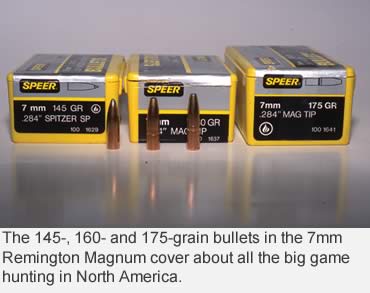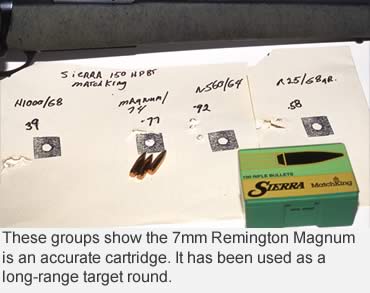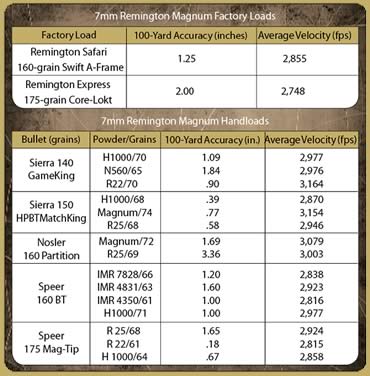All hail the 7mm Rem Mag — king of the .284 bores.
The 7mm Remington Magnum is the most bought, shot and hunted-with magnum cartridge, despite the continuous introduction of other magnum rounds intended to capture some of its appeal.
The 7mm Rem Mag acquired its rank soon after it was introduced way back in 1962 and has held onto that spot over the ensuing decades because it has proven a cartridge its size delivers about all the performance that can be expected from a 7mm bore.
When I was chewing over buying a magnum 30 years ago, most of my friends had already bought .300 Winchester Magnums. I shot their rifles but handed them back because they kicked too hard. I simply couldn’t shoot the .300 Win Mag well from the prone position because a little voice in the back of my mind warned, “When you pull the trigger, it’s going to hurt!” There was little sense of owning a rifle intended primarily for long-range shooting if my accuracy with it from the prone position was as sour as owl droppings.
Still, I wanted a long-range magnum. I noted what other hunters were saying and read every magazine article I could about hunting cartridges. I heard a lot of good talk about the 7mm Rem Mag. I finally took the plunge and bought a Remington Model 700 Classic in that caliber.
 The rifle kicked noticeably more than the .270 Winchester and .30-06. But shooting it regularly helped accustom me to its recoil. After a summer’s practice, I could shoot from the prone position and do quite well with the rifle at long range.
The rifle kicked noticeably more than the .270 Winchester and .30-06. But shooting it regularly helped accustom me to its recoil. After a summer’s practice, I could shoot from the prone position and do quite well with the rifle at long range.
The first couple of hunting seasons, I thought the 7mm Rem Mag was the greatest thing since wool socks. I aimed right on a couple of pronghorn antelope and mule deer way out there and dropped them with one shot apiece.
I’d bought the rifle mainly to hunt elk, and the first bull I got a chance at with the rifle was a 6-pointer. At morning light, the elk was coming up from a field into the hills. I ran as fast as I could to get ahead of it. The animal walked around a hill into view 200 yards out just as I’d sat down and caught my breath. As it walked along, I tracked it through my scope with the crosshairs at the front of its chest. At the shot, the bull stopped. I shot again, and that was it. When I got to the animal, I was surprised to see both bullets had gone completely through it. That was something that rarely happened with my old .30-06.
Loads for the Big Seven
Everything remained wonderful with the 7mm Rem Mag for the next few hunting seasons. Then my wife bought me a chronograph for my birthday. The machine nearly ruined my confidence in the cartridge. Factory-loaded 7mm rounds with 160-grain bullets produced about 2,800 feet per second. My handloaded 160-grain bullets with IMR-4350 powder had about the same muzzle velocity. The 140-grain bullets I handloaded barely beat the velocity of 130-grain bullets from my old .270 Winchester.
Other powders like H-4831, IMR-4831 and IMR-7828 boosted the velocity of 160-grain bullets to slightly less than 3,000 fps. At least in my mind, that was somewhat better.
I used the rifle over the following years to take more game and liked how it handled and the cartridge performed. But I was no longer fooled there was magic to the 7mm Remington Magnum.
In the following years, even slower-burning powders were introduced. These filled the 7 mag’s big case and increased velocity of 160- and 175-grain bullets 100 to 200 fps over other powders. When H-1000 was first introduced, I was told to try a maximum load of 74 grains of it with a 160-grain bullet. I worked up to that amount with a Nosler 162-grain Solid Base bullet. The muzzle velocity was 3,160 fps. Pressure seemed fine. Since then, though, new loading manuals list around 71 grains of H-1000 as the maximum. A 7mm rifle with a 26-inch barrel, though, produced nearly 3,100 fps with 160-grain bullets and 69 grains of H-1000. In the same rifle, 72 grains of Ramshot Magnum generated nearly 3,100 fps. With 175-grain bullets, 68 grains of Reloder 25 turned in 2,924 fps.
 Still, none of these new powders boosted the velocities of 140-grain bullets all that much. At the most, several different 7mm mag rifles get about 3,200 fps with this bullet weight. That’s about a 200 fps increase over the 7mm-08 and .280 Remington, which is not enough news to buy a stamp and write home about. However, nothing is the matter with a 140-grain bullet flying 3,200 fps from a 7mm magnum. With such a load zeroed at 200 yards, a hunter must only put a bit of daylight between the crosshairs and the top of a buck’s back to hit an antelope at 400 yards. The Barnes 140-grain X-Bullet exiting my 7mm magnum at that speed has taken two black bears and quite a few antelope and elk.
Still, none of these new powders boosted the velocities of 140-grain bullets all that much. At the most, several different 7mm mag rifles get about 3,200 fps with this bullet weight. That’s about a 200 fps increase over the 7mm-08 and .280 Remington, which is not enough news to buy a stamp and write home about. However, nothing is the matter with a 140-grain bullet flying 3,200 fps from a 7mm magnum. With such a load zeroed at 200 yards, a hunter must only put a bit of daylight between the crosshairs and the top of a buck’s back to hit an antelope at 400 yards. The Barnes 140-grain X-Bullet exiting my 7mm magnum at that speed has taken two black bears and quite a few antelope and elk.
One of those elk was a 5-pointer in the timber. It was standing maybe all of 60 yards away on a steep hill. It took the bull about two seconds to figure my silhouette above it meant danger and cut downhill to run. Just as the bull turned, though, the bullet found its mark. The elk’s legs buckled, and it slid down the hill 40 yards and crunched up against a tree.
In my mind, a 160-grain bullet at 3,100 fps makes the best all-around 7mm Rem Mag load. That weight bullet has a trajectory within a couple of inches of the 140 grain out to 400 yards and packs more energy when it gets there. A stoutly constructed 160-grain also tears up less meat.
I took a mule deer one time with my 7mm magnum shooting a 140-grain bullet constructed with a lead core and thin copper-alloy jacket. Even though the bullet hit perfectly broadside and behind the shoulder, it bloodshot both shoulders and some of the meat along the backbone. Needless to say, the deer never took a step.
That’s when I switched permanently to a 160-grain bullet. I have shot whitetails and antelope with Nosler 160-grain Partitions, and the bullets poked neat holes in and out of the game. A few of them took off on a blind run for 20 or 30 yards and then fell. When I field-dressed them, there was next to no bloodshot meat, but the lungs had been turned to soup.
The 160-grain bullets also provide all the penetration anyone should expect from an expanding hunting bullet. One time I watched my brother-in-law shoot a 160-grain Fail Safe bullet from my 7mm (it’s a long story how he ended up with my rifle) completely lengthwise through a huge bull elk. This past fall, I watched a father and son use their 7mm magnums to each take a bull elk. The Speer 160-grain Grand Slam bullets they used went clean through the animals.
With penetration like that, there’s little need to shoot a 175-grain bullet in the 7mm magnum. Not that there is anything wrong with shooting a 175-grain bullet at 2,900 fps from a 7 mag if real big game like an Alaskan moose is on the menu. But that weight bullet is mostly a holdover from the days when the 7mm Remington hit the market and hunters began to move from the .30 caliber toward this smaller bore. Slowly, hunters discovered that 160-grain bullets fired from their 7mms fairly well duplicated the penetration of 180-grain .308-caliber bullets on large game like elk.
 In fact, in all the years I have been shooting a 7mm magnum, I haven’t noticed a bit of difference on game between my 7mm shooting 160-grain bullets and my friends’ .300 Winchester Magnums shooting 180-grain bullets. There really shouldn’t be, either. The difference in weight between the two bullets is half the weight of a .22 Long Rifle bullet. When both bullets are started at the same velocity, the .300 carries 200 foot-pounds more energy and drops a few inches less at 500 yards than the 7mm. I’ll gladly trade that for a slightly lighter rifle and less kick.
In fact, in all the years I have been shooting a 7mm magnum, I haven’t noticed a bit of difference on game between my 7mm shooting 160-grain bullets and my friends’ .300 Winchester Magnums shooting 180-grain bullets. There really shouldn’t be, either. The difference in weight between the two bullets is half the weight of a .22 Long Rifle bullet. When both bullets are started at the same velocity, the .300 carries 200 foot-pounds more energy and drops a few inches less at 500 yards than the 7mm. I’ll gladly trade that for a slightly lighter rifle and less kick.
The Competition
A lot of other hunters concur, because the 7mm Rem Mag remains a very popular cartridge. From what I see hunters carrying in the field, it’s right up there with the .300 Winchester Magnum. Certainly it’s the most popular 7mm cartridge. A long line of other 7mm rounds have come along to battle the 7mm Remington for market share. Let’s see how they’ve fared.
Two 7mm magnum cartridges were on the market well before Remington introduced its 7mm mag. The 7x61mm Sharpe & Hart came along in 1953 in Schultz & Larson bolt-action rifles, and ammunition was originally loaded for it by Norma and then for a short while by Federal. Today the cartridge is just a footnote in cartridge history. The 7mm Weatherby Magnum was one of a series of Weatherby cartridges based on an altered .300 H&H Magnum case. It came along in 1944 in Weatherby rifles. In 1991, Remington offered the Model 700 Classic rifle and the standard Model 700 in 7mm Weatherby Mag. Today, only Weatherby rifles are chambered for the cartridge.
The .280 Remington came along in 1957 as a “hunt all game” cartridge. The launch of the 7mm magnum five years later put a big dent in .280 sales. The round has been comatose ever since. The 7mm STW hung around for years as a wildcat cartridge until 1997, when Remington gave it a step up and started chambering rifles and loading ammunition for it. This big cartridge requires a magnum-length action and provides about 150 fps more bullet speed than the 7mm Remington. It was quite popular for a few years, but rifles for it are available now only through Remington’s custom shop.
The 7mm Remington Ultra Magnum is more of the same. Its slight velocity advantage over the original Remington magnum comes at the expense of burning 15 to 20 grains more powder, increased recoil and a rifle with a longer action and barrel. Remington has been chambering the cartridge since 2000. But few hunters have voted with their credit cards in favor of this biggest seven.
Remington’s 7mm Short Action Ultra Magnum and Winchester’s 7mm Short Magnum should give the 7mm Remington a run. The three cartridges fairly well mirror each others’ ballistics. The two short cartridges, though, are made in short actions that enable somewhat lighter rifles. But it seems hunters don’t mind carrying a few extra ounces. The 7mm RSAUM never gained acceptance when it was introduced in 2003, and now is largely ignored. The 7mm WSM has done little better and is noticeable only by its absence in the cartridge lineup for the new Winchester Model 70.
No, the 7mm Remington Magnum is here to stay. Hunters have been buying and hunting with this most popular magnum for going on 50 years. Unless a truly magical cartridge comes along, hunters will continue carrying it afield for the next 50 years.
This article was published in the August 2008 edition of Buckmasters GunHunter Magazine. Subscribe today to have GunHunter delivered to your home.